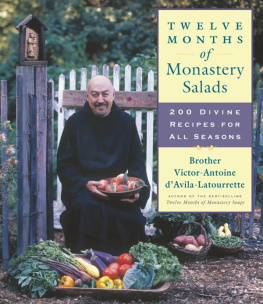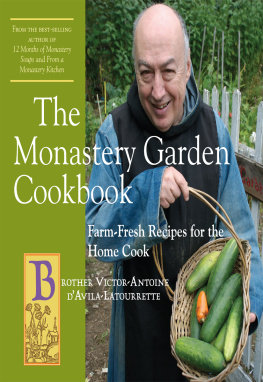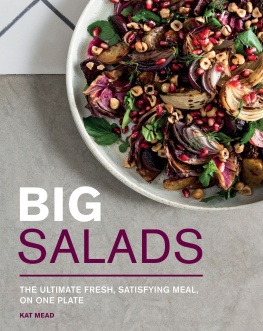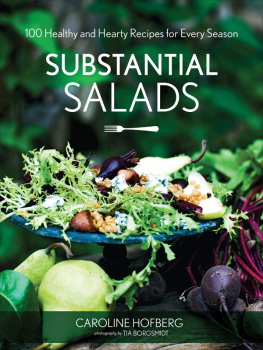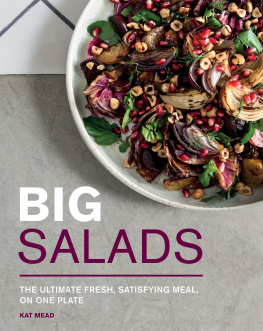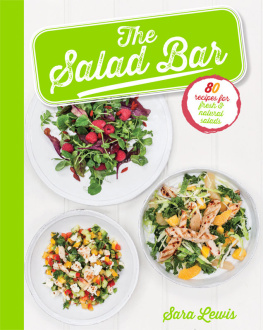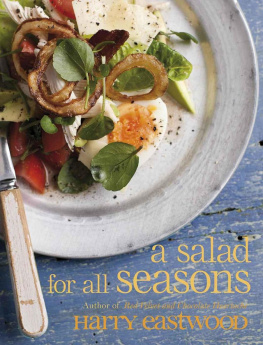T HE H ARVARD C OMMON P RESS
535 A LBANY S TREET
B OSTON , M ASSACHUSETTS 02118
www.harvardcommonpress.com
Copyright 2004 by Brother Victor-Antoine d'Avila-Latourrette
All rights reserved. No part of this publication may be reproduced or transmitted in any form or by any means, electronic or mechanical, including photocopying, recording, or any information storage or retrieval system, without permission in writing from the publisher.
Printed in the United States
The Library of Congress has cataloged the hardcover edition as follows:
D'Avila-Latourrette, Victor-Antoine.
Twelve months of monastery salads : 200 divine recipes for all seasons / Brother Victor-Antoine d'Avila-Latourrette.
p. cm.
ISBN 1-55832-277-9
1. Vegetarian cookery. 2. Monastic and religious life. I. Title.
TX837.D235 2004
641.8'3dc22
2003024061
ISBN: 978-1-55832-332-2
Special bulk-order discounts are available on this and other Harvard Common Press books. Companies and organizations may purchase books for premiums or resale, or may arrange a custom edition, by contacting the Marketing Director at the address above.
10 9 8 7 6 5 4 3 2 1
B OOK DESIGN BY D EBORAH K ERNER /D ANCING B EARS D ESIGN
C OVER PHOTOGRAPH BY K IM G RANT
T O J EANNE -M ARIE AND H OMER B YINGTON
AND M ARY J EAN AND J OHN W INKLER ,
FOR THEIR FAITHFUL FRIENDSHIP, SUPPORT ,
AND LOVE ALL THESE YEARS

A meal, however simple, is a moment of intersection.
Elise Boulding

Acknowledgments
I wish to thank our friends in France and here in the U.S.A., especially my dear cousins Anne-Marie and Bernard Cazenave-Latourrette from Pau, France, who shared some of their favorite salad recipes with me. I also wish to thank Louise Seamster, Aaron Ancel, and Michael Centore, all from Vassar College, who collaborated and helped in so many of the monastery tasks, including at times typing and rearranging the recipes.
Last but not least, I am most grateful to The Harvard Common Press for wanting to do this book, in particular to Pam Hoenig, my editor, who worked endless hours to make this book a reality.

Introduction
For the ear tests words, as the palate tastes food.
B OOK OF J OB 34:3
There was a time when both professional chefs and ordinary cooks looked at salads as a secondary dish on the menu, not terribly important to everyday cooking, something added to the meal only for special occasions, such as a feast or celebration. This has changed in the last few decades and we are all the better for it. The great interest that surged in the late sixties in a healthy, fresher, and more natural cuisine has done wonders to expand the scope and value of salad as a unique resource. Salads, rich sources of vitamins and minerals, are the prototype of what is considered healthful eating.
Main course salads, which artfully combine vegetables, fruits, seafood, cheese, grains, pasta, and meat, have become favorites during the hot weather months and beyond. People now savor and enjoy salads all year round. We have only to look at the trendiness of salad bars to see this. Some of the reasons salads are so popular are that they are easy to put together, there are endless variations to please every taste and palate, and they seem to always provide a wonderful contrast of flavors, textures, colors, and nuances. There are salads that can be prepared well ahead of time and others that can be quickly arranged at the last minute. If one finds one's fridge full of leftover fruit and vegetables, one has only to think of salad and all these ingredients will find their rightful place in the salad bowl. There is a certain balance, a certain harmony in a well-prepared and -arranged salad, which gives it a unique appeal. All the ingredients seem to blend effortlessly, creating the perfect plate, full of delicacy and wonder.
Salads today are deeply appreciated by all, no matter where they appear in the meal. They can be the perfect starter, an attractive main course, or a delightful in-between or finish to an appetizing meal. I myself put great emphasis on the salad as a main course two or three times a week during the summer months, for besides simplifying the task of food preparation in the kitchen, the salad is a natural answer to a monastic diet that stresses the consumption of vegetables, grains, fruits, and less saturated fats.
Salads, like soups, have always played an integral role in monastic cuisine. Monastic cooking is well known for its simplicity, wholesomeness, sobriety, and basic good taste. These are principles that mark a certain approach to cooking and are reflected in the dishes concocted in monasteries. Both salads and soups are seen as perfect prototypes for these principles and are considered quintessentially monastic sorts of foods.

Monastic cooking relies a great deal on the seasonal harvest of our gardens, farms, and orchards. Monks know that nothing can compare with the freshness and excellence of the products grown within the confines of the monastic enclosure. Nothing is so deeply appreciated at the monastic table as a well-arranged, well-balanced salad, the end result of our own cultivation and the thrifty creativity of the monastic kitchen.
The salads presented in this collection tend to be basically vegetarian, thus adhering to the principle of the monastic diet as prescribed in the Rule of St. Benedict. Dairy products and seafood are allowed, and consequently are included in some of the salads you'll find within these covers. The immense variety of salad recipes in this book remains faithful to its monastic inspiration. (There are a few exceptions, like ones calling for luxury items such as caviar, which are included for the benefit of those who don't adhere to a strict monastic diet.) The recipes here exalt the values of health, nutrition, and refinement of taste. A salad, carefully prepared, is always an occasion for celebration.
Bon apptit!
B ROTHER V ICTOR -A NTOINE
S OLEMNITY OF S T . B ENEDICT

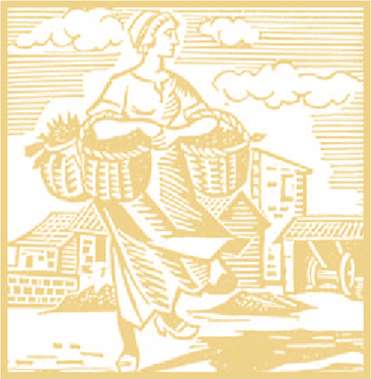
SALAD BASICS
The immense variety of salad greens now available in our gardens, in the supermarkets, and at local roadside stands can be overwhelming at times. With such diversity to choose from, one hardly knows where to begin. Each of the seasons provides its own harvest of delicious, crisp greens to tempt our appetites. Every season also brings new hybrid varieties, which provide their own intriguing flavors. The true connoisseur or well-trained chef knows that to create a magical salad, one must combine some zesty greens, such as arugula, with some milder ones, such as red oak-leaf lettuce, in order to achieve a delicious harmony of flavors. Mesclun is an example of a perfect blend of flavors, textures, and tenderness, hence its rich appeal.
Next page
